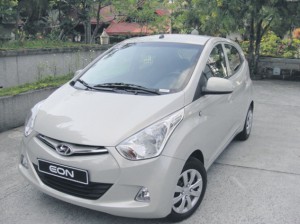Just when everyone thought that the i10 was Hyundai Motor’s tiniest, lowest priced, most fuel-efficient mini subcompact car, Korea’s No. 1 carmaker came up with an even smaller, lower-priced fuel sipping 5-door hatchback called the Eon. But when the Eon was unveiled at the 8th Manila International Auto Show last April, it was hardly noticed because all eyes were on the sporty Veloster coupe that Hyundai Asia Resources Inc. (HARI) introduced at the same time.
Nonetheless, with a no-frills GL variant priced at only P438,000, or P40,000 less than the i10 GL, the Eon is poised to grab market share from competitors in the below P500,000 entry-level segment, which is booming as oil prices continue to fluctuate. Fact is, the Eon is like a pioneer because it is the first 800 cc, 3 cylinders-in-line motor vehicle to be commercially offered in our country.
Being priced so competitively, the Eon is obviously targeting young consumers who are buying a new car for the first time but who are limited by a low budget. More mature buyers who need a nimble, economical second or third car to run errands in urban centers would also consider the Eon.
Aerodynamic. Hyundai raised the bar in this segment by designing the Eon to be not only frugal with fuel, but also stylish and loaded with features not usually found in budget cars. Hyundai’s revolutionary wind-swept, fluidic design language was applied tastefully, keeping the car’s small dimensions (length, 3495 mm; width, 1550 mm; height, 1500 mm) and an aerodynamic profile in mind. The clear-type headlamps sweep back the entire length of the hood, sculpted lines enhance the sides and bulging wheel arches highlight the wheel caps that can pass for alloy wheels. An integrated rear spoiler with high-mount stop lamp plus large, half-moon shaped tail lights add a classy touch to the hatchback. Beside the aerodynamic Eon, with its 0.35 coefficient of drag, rival mini-subcompacts look boxy and outdated.
Inside, the two-tone color scheme, quality materials and upscale dashboard with integrated audio system complement the stylish exterior. The central gauge cluster has a welcoming light and green lights showing the fuel level and engine temperature instead of needles. In lieu of a tachometer, the Eon has a gear shift indicator guide that helps the driver to drive efficiently and optimize fuel economy.
The steering wheel in the GLS variant (P498,000) is tilt adjustable and the AM/FM tuner with CD has MP3, Aux-in and USB ports plus four speakers. While the GL variant has only two speakers in front, space is provided behind the rear seat for the installation of after-market ones.
Space is an important factor when shopping for a small car and the Eon aces this test by providing ample headroom and legroom for front seat occupants and cargo space with a 215-liter capacity even with the rear seat up. With the bench-type rear seat folded down, cargo space is increased.
While the front seats are comfy and provide adequate back support, the seat width may be too narrow for hefty persons. Leg room and headroom are cramped in the back due to the sloping roofline. But cup holders, door map pockets and cubbyholes abound fore and aft together with an open storage tray at the center fascia, a spacious glove box and a floor console. And the powerful, manually operated air conditioner with 4-speed blower guarantees cool climate control.
In both the GL and GLS variants, only the front windows are power-operated. The GLS costs P60,000 more because it has central door locking, keyless entry, a driver’s side SRS airbag, covering shelf in the cargo area, and up/down adjustable front seat headrests aside from front fog lamps, tilt-adjustable steering wheel, body-color bumpers, door handles, side mirrors and a body color with chrome hexagonal grille.
Solid. Despite its mini size, the Eon is built solidly with no uneven panel gaps and no squeaking or rattling on bumpy roads, although the ride gets bouncy over craters. The 0.8-liter, 3-cylinder Epsilon engine mated to a 5-speed manual transmission produces 55 bhp at 5500 rpm and 75 Newton meters max torque at 4000 rpm. Steering complexity and weight are reduced by Motor-Driven Power Steering, which at the same time helps improve fuel economy and steering response, Hyundai claims.
At low speeds on smooth surfaces, the ride is compliant although the 3-pot motor gets loud and vibrates a bit at higher revs. While NVH levels need to be lowered, the Eon remains impressively stable and planted even at speeds exceeding 100 kph, thanks to the MacPherson strut front suspension linked to an i-shaped, compact front subframe and a stabilizer mounted directly on the strut. A torsion beam axle constitutes the rear suspension.
The Eon’s engine strains to hit 100 kph and up, but hey, it’s only an 814-cc, 3-cylinder motor. Despite the absence of ABS, the brakes (discs in front, drums at the rear) perform crisply, stopping in a straight line to zero from the car’s top speed of 120 kph with no sideways movement. With such a small engine and low gross vehicle weight (1190 kg), Hyundai claims that the Eon gets 26.3 km per liter on the highway, but 17-18 km per liter in combined city and highway driving is more likely.
Summing up, the Eon offers best-in-class value for money with its fuel efficiency, solid build quality, eye-candy aerodynamic styling, upscale features and interior amenities.
